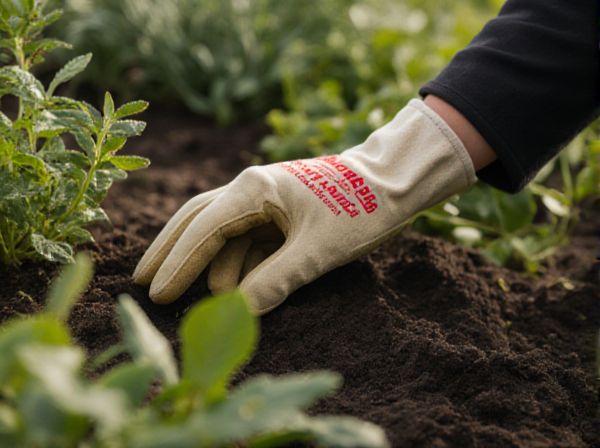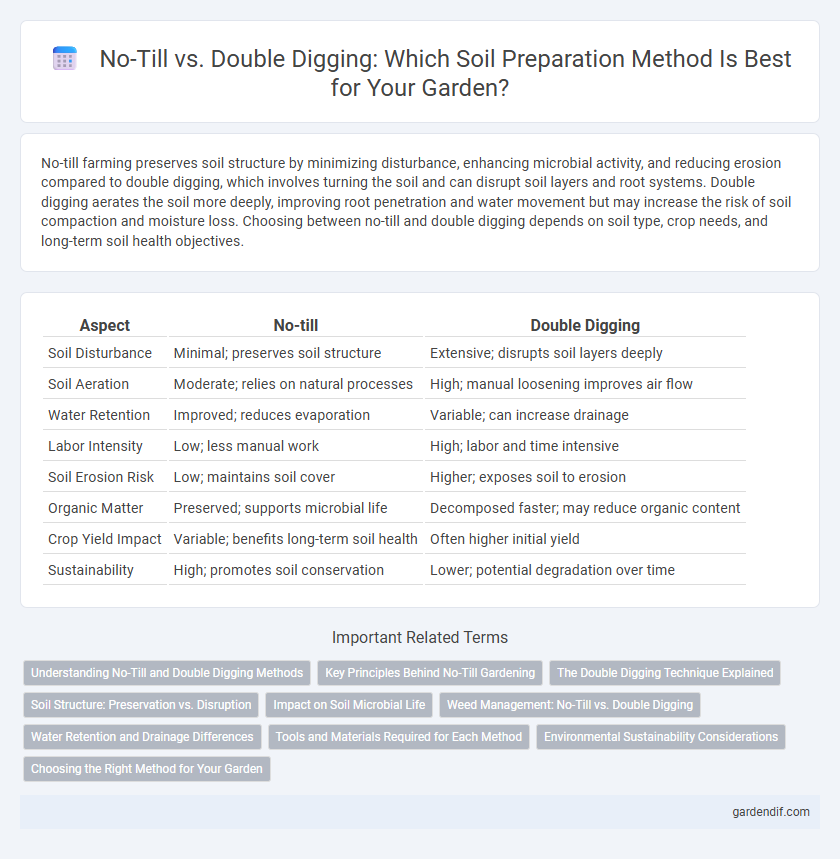
No-till vs Double digging Illustration
No-till farming preserves soil structure by minimizing disturbance, enhancing microbial activity, and reducing erosion compared to double digging, which involves turning the soil and can disrupt soil layers and root systems. Double digging aerates the soil more deeply, improving root penetration and water movement but may increase the risk of soil compaction and moisture loss. Choosing between no-till and double digging depends on soil type, crop needs, and long-term soil health objectives.
Table of Comparison
| Aspect | No-till | Double Digging |
|---|---|---|
| Soil Disturbance | Minimal; preserves soil structure | Extensive; disrupts soil layers deeply |
| Soil Aeration | Moderate; relies on natural processes | High; manual loosening improves air flow |
| Water Retention | Improved; reduces evaporation | Variable; can increase drainage |
| Labor Intensity | Low; less manual work | High; labor and time intensive |
| Soil Erosion Risk | Low; maintains soil cover | Higher; exposes soil to erosion |
| Organic Matter | Preserved; supports microbial life | Decomposed faster; may reduce organic content |
| Crop Yield Impact | Variable; benefits long-term soil health | Often higher initial yield |
| Sustainability | High; promotes soil conservation | Lower; potential degradation over time |
Understanding No-Till and Double Digging Methods
No-till farming preserves soil structure by minimizing disturbance, enhancing organic matter retention, and reducing erosion compared to double digging, which involves deep soil turning to improve aeration and root penetration. While no-till promotes microbial diversity and moisture conservation, double digging disrupts soil layers, potentially accelerating nutrient cycling but increasing labor intensity. Choosing between these methods depends on specific soil health goals, crop types, and long-term sustainability considerations.
Key Principles Behind No-Till Gardening
No-till gardening preserves soil structure by avoiding disturbance, promoting microbial activity and organic matter retention essential for nutrient cycling. This method relies on maintaining ground cover and using mulch to reduce erosion and moisture loss, enhancing soil health over time. In contrast to double digging, no-till minimizes compaction and preserves the natural soil ecosystem, fostering sustainable plant growth.
The Double Digging Technique Explained
The double digging technique involves meticulously loosening two layers of soil to enhance aeration, drainage, and root penetration in garden beds. This method significantly improves soil structure by breaking up compacted layers, promoting microbial activity, and increasing nutrient availability, resulting in healthier plant growth. Compared to no-till practices, double digging requires more labor but offers immediate improvements in soil texture and fertility, ideal for new or heavily compacted garden areas.
Soil Structure: Preservation vs. Disruption
No-till farming preserves soil structure by minimizing disturbance, maintaining soil aggregates, and enhancing microbial activity, which leads to improved water retention and reduced erosion. In contrast, double digging disrupts soil layers by turning and loosening the soil deeply, which can temporarily improve aeration but often breaks down soil aggregates and harms beneficial organisms. Long-term no-till practices foster stable soil porosity and organic matter integration, while repeated double digging risks structural degradation and compaction over time.
Impact on Soil Microbial Life
No-till farming preserves soil microbial life by maintaining soil structure and organic matter, fostering diverse microbial communities critical for nutrient cycling. Double digging, while aerating soil layers and promoting root growth, often disturbs microbial habitats and reduces microbial biomass temporarily. Studies show no-till practices enhance microbial diversity and activity more sustainably compared to the disruptive effects of double digging.
Weed Management: No-Till vs. Double Digging
No-till farming significantly reduces weed emergence by preserving soil structure and preventing weed seed disturbance, thereby minimizing the seed bank on the soil surface. In contrast, double digging aerates the soil but disrupts soil layers, which can bring dormant weed seeds to the surface and increase weed pressure. Effective weed management in no-till systems often relies on cover crops and mulch, while double digging requires more frequent manual or chemical weed control.
Water Retention and Drainage Differences
No-till farming enhances water retention by preserving soil structure and organic matter, leading to improved moisture infiltration and reduced evaporation. Double digging, while aerating deeper soil layers, can disrupt existing soil aggregates, potentially increasing drainage but also risking moisture loss. The balance between water retention and drainage differs as no-till promotes surface moisture conservation, whereas double digging encourages deeper water movement and aeration.
Tools and Materials Required for Each Method
No-till farming requires specialized equipment such as no-till seed drills and coulters to plant seeds directly without disturbing the soil structure, reducing erosion and preserving soil moisture. Double digging demands manual tools like spades, forks, and sometimes wheelbarrows for intensive soil loosening and aeration, improving root penetration but increasing labor input. Materials for no-till often include cover crops and mulch to protect the soil surface, whereas double digging may require compost or organic matter incorporated during the digging process to enhance fertility.
Environmental Sustainability Considerations
No-till farming significantly reduces soil erosion and enhances carbon sequestration by maintaining soil structure and organic matter, thereby supporting long-term environmental sustainability. Double digging, while improving aeration and root penetration, can disrupt soil microbial ecosystems and increase CO2 emissions due to extensive soil disturbance. Choosing no-till practices aligns better with sustainable agriculture goals by minimizing soil degradation and promoting biodiversity.
Choosing the Right Method for Your Garden
No-till gardening preserves soil structure and microbial life by minimizing disturbance, promoting long-term soil health and moisture retention. Double digging aerates and loosens compacted soil deeply, enhancing root penetration and nutrient access, ideal for heavy clay or compacted soils. Choosing between no-till and double digging depends on your garden's soil condition, crop needs, and long-term sustainability goals to optimize growth and soil fertility.
No-till vs Double digging Infographic

 gardendif.com
gardendif.com